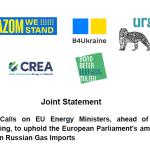
Brought to you by the Together for 100% Renewable Europe Campaign
Why a EU Solar Standard?
Accelerating solar energy deployment, both photovoltaic (PV) and solar thermal, in buildings, coupled with energy savings and demand-side flexibility activation, is critical to increase the resilience of Europe’s energy system and mitigate the climate crisis. Recognising the pivotal role of solar energy, cross-sector support has rallied behind an ambitious EU solar mandate. The ongoing revision of the Energy Performance of Buildings Directive (EPBD) serves as a strategic catalyst for embracing the power of the sun for our buildings.
A solar standard, or ‘mandate’, requires newly constructed or majorly renovated structures -such as public, private and residential buildings, or even car parks – to incorporate solar energy systems. These mandates demand that a building’s energy needs, at least in part, are fulfilled by solar technologies such as photovoltaic (PV) for electricity and solar thermal for heat. Importantly, such mandates will also facilitate cities finally playing a pivotal role in the energy transition. The solar potential of artificial and built surfaces, such as rooftops, transport infrastructure, and parking areas, remains largely untapped, and harnessing this potential could significantly advance our renewable energy ambitions.
In Austria, Belgium, Bulgaria, France, Greece,Italy, the Balearic Islands (Spain), the Netherlands and 9 out of 16 German federal states, solar energy installation requirements are either already in force or are being initiated. These mandates aim to harness the significant potential of solar energy in buildings, transforming them from passive energy consumers into active producers. By doing so, we can reduce our reliance on costly and dangerous fossil fuels, paving the way for a more sustainable and resilient energy future for all of us.
| Best practice from Baden-Württemberg, Germany.
Since 1 May 2022, photovoltaics have been mandatory for new residential buildings in Baden-Württemberg, and from January 2023, it has also applied to all major roof renovations. The mandatory step for new buildings to comply with is certainly the easiest option and seems by far the most logical measure. However, there is a huge potential in existing roofs, which should play a role. It is assumed that a rough estimate of 80 percent of the roof areas that are created are to some extent suitable for solar use. This also applies to roof areas for existing buildings. The southern German state of Baden-Württemberg proves that a solar standard is possible. |
While the specifics of a solar mandate may vary between countries and regions, a rigorous regulatory framework at the EU level would lay a robust foundation for the wider implementation of solar installations in all the Member States. This would allow millions of Europeans (especially tenants in urban areas) to significantly benefit from renewable energy technologies and help them become less dependent on fossil fuels.
Integrating considerations of technical suitability and economic or functional feasibility into nationally defined criteria, which should be evidence-based, will ensure a more pragmatic enforcement of the solar obligation. To ensure that the “solar energy revolution” is accessible for more and more segments of consumers, especially those most in need, the solar standard must ensure that with strong regulation, the needed enablers and support mechanisms are embedded within the framework.
Boosting Solar Momentum through the EU’s Building Directive
The Energy Performance of Buildings Directive (EPBD) has been a keystone of EU legislation, focusing on how to improve the energy performance of our buildings but it could also unlock their solar-power potential. As a part of the EU’s REPower plan – a strategy aimed at reducing dependence on Russian fossil fuels and accelerating the energy transition – the inclusion of ‘solar energy in buildings’ provides an excellent opportunity to embed the growing solar momentum at its heart.
The ongoing negotiations between the different EU bodies (Council, Parliament and Commission) referred to as ‘trilogues’, should establish a swift roadmap for implementation, and encompass as many buildings as feasible from the onset. Immediate implementation of solar standards for all new structures and roofed car parks, regardless of their purpose or ownership status, is vital. These standards serve the dual purpose of benefiting citizens and businesses, whilst also contributing to our joint goal of a safer climate.
Towards a Holistic Approach for Buildings
With buildings responsible for a significant 40% of the EU’s total energy consumption and 36% of greenhouse gas emissions, the journey to climate neutrality critically depends on a comprehensive strategy for the building sector. This strategy must merge energy renovation efforts with the deployment of solar installations, renewable heating solutions, building automation and control systems (BACS), among others. Far from being an optional alternative, this integration represents an indispensable step. Furthermore, as renewable energy use in buildings increases, it should be paralleled by supportive measures for demand-side flexibility options such as electric vehicle (EV) charging stations, heat pumps, and energy storage.
By strategically leveraging key stages in a building’s life, such as major or deep renovations, we can unlock the much-needed potential for a holistic approach to building renovation. This approach encompasses various actions, including improvements to the building envelope, the deployment of renewable heating systems, and the installation of solar panels. This will facilitate the smart integration of buildings into the energy system, foster a more proactive role for buildings in grid balancing, and relieve consumers’ energy bills as reliance on fluctuating fossil fuels decreases.
Furthermore, pairing solar PV installation with the use of heat pumps helps reduce fossil gas consumption and brings down electricity bills. When coupled with energy demand (e.g., insulation) and demand-side flexibility measures, the energy savings potential becomes even more significant, helping consumers’ with their energy bills and overall functioning of the electricity grids by easing up peak load demand. Those are vital steps towards an overarching transformation of the building sector in becoming climate neutral.
In conclusion, the abundant yet largely untapped potential of solar energy within EU’s buildings is an opportunity we cannot afford to overlook. As negotiations around the EU solar standard continue, it is essential for EU lawmakers to forge a robust, ambitious regulatory framework that (a) boosts the energy transition and (b) is made accessible for all Europeans. This framework will not only guide Member States in their efforts but also be a catalyst for our transition towards a future powered by 100% renewable energy – a future that is flexible, resilient, and puts people at its heart.
Written by Sebastian Breer, Climate and Energy Policy Advisor at WWF Deutschland and Eva Brardinelli, Buildings Policy Coordinator at CAN Europe



